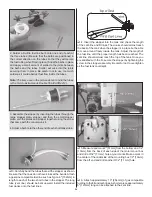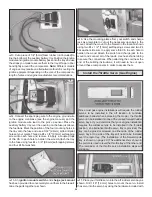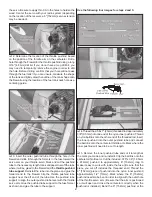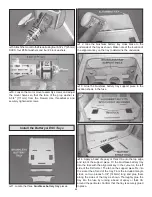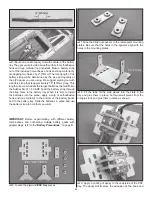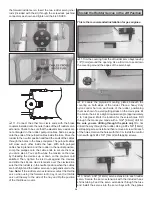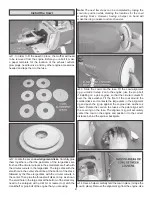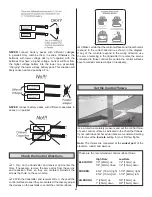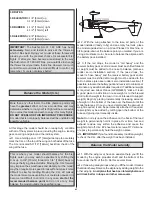
31
loop material (not included). When the epoxy has cured
completely, attach your ESC to the underside of the ESC
tray with self-adhesive hook and loop material. Depending
on the size of the ESC you are using, it can be properly
secured to the tray using a rubber band or the included 8"
[200mm] tie straps.
❏
10. Insert a 4-40 blind nut into each of the four blind nut
spacers. Attach the ESC tray to the aluminum brushless
mount using four 4-40 x 3/4" [19mm] machine screws, four
#4 fl at washers and threadlocking compound. The screws
should pass through the ESC tray side pieces, through a
set of unused holes in the aluminum motor mount and into
the blind nuts in the mounting plates. If the aluminum blocks
used to hold the two aluminum motor mount halves together
interfere with the plywood ESC mounting plates, you may
need to remove the screws holding the mount together and
move the aluminum blocks further away from the center.
INSTALL THE RUDDER SERVOS
These two sections refer to installing the rudder servos
in the forward position utilizing a pull-pull system and
installing them in the aft position utilizing pushrods. If you
have not yet decided which installation is necessary for
your power system, consider the following for each type:
Glow Engine
The weight of the O.S. 1.60 FX and Pitts muffl er (39 oz
[1106g]) requires that the rudder servos be installed in the
forward position utilizing a pull-pull rudder system to balance
the airplane at the recommended C.G. with the addition of
extra ballast at the nose of the plane. If you are installing an
engine that is heavier than the 1.60 FX, you may wish to
check the current C.G. of the plane before proceeding.
Gas Engine
Most gas engine installations (including the Fuji-Imvac
BT-43 EI-2 engine) will require the rudder servos to be
installed in the aft position. We suggest checking the balance
before you proceed with the rudder servo installation if you
are installing a lighter engine. The Fuji-Imvac BT-43 EI-2
weighs 64 oz [1814g] with the muffl er, EI unit, prop bolt and
prop washer (also consider the weight of the ignition battery
pack you will be using).
Brushless Motor
Battery size and voltage will ultimately determine the
optimum rudder servo position. However, the battery
confi gurations that we have tested result in a slightly tail
heavy model, requiring that the rudder servos be installed
in the forward position. We suggest checking the balance
of the airplane at this time before proceeding with the
rudder servo installation.
Checking the Current Balance of the Model
Check the balance of the model by installing the wing onto
the fuse, sliding the cowl over the fi rewall and taping it in
place (it’s okay if the cowl is not on the fuse straight), and
installing your propeller and spinner. These components
only need to be loosely installed and are only for checking
balance of the plane. Follow the balancing procedure
described on page 43 of this manual. With the C.G. set at
the recommended distance, experiment with the rudder
servos by placing them both into the forward rudder servo
tray, as well as resting them on the tail of the plane near
the LE of the stab. The receiver battery pack should also
be placed either onto the radio tray near the throttle servo,
or above the position of the fuel tank.
Summary of Contents for GPMA1412
Page 52: ......








